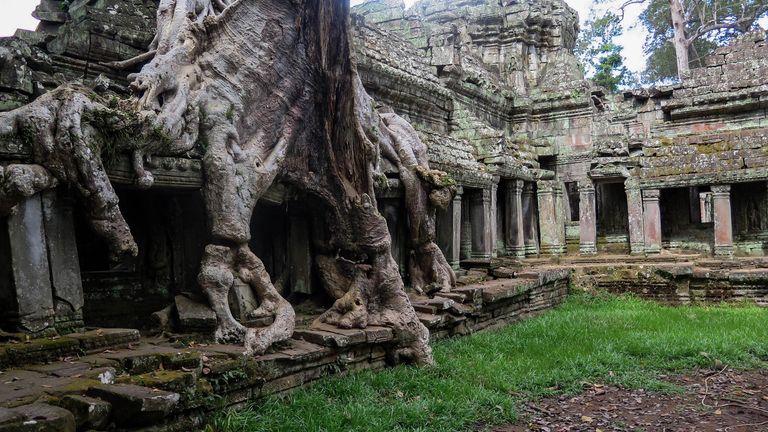
The ancient temples of Angkor Wat in Cambodia are not only a testament to the Khmer civilization's architectural and artistic achievements, but also a living museum of nature's power and beauty. Among the many wonders of this UNESCO World Heritage Site, one of the most striking features is the presence of giant trees that have grown on, over and through the stone structures, creating a surreal and mystical landscape.
These trees belong to three main species: the strangler fig (Ficus gibbosa), the silk-cotton tree (Ceiba pentandra) and the thitpok tree (Tetrameles nudiflora). They are common in tropical forests throughout the world, but have found a unique niche in the ruins of Angkor Wat. They have adapted to the harsh conditions of the site, such as poor soil, lack of water and exposure to sun and wind, by developing extensive root systems that anchor themselves to the stones and reach for moisture and nutrients.
The most famous and impressive example of these trees is the strangler fig, which has earned its name by its parasitic habit of wrapping its roots around a host tree and eventually killing it. In Angkor Wat, however, the strangler figs have found another host: the temples themselves. The figs start as seeds that are dropped by birds or monkeys on the roofs or crevices of the temples. They then send down aerial roots that penetrate the cracks and gaps in the stones, gradually expanding and splitting them apart. The roots also grow upwards and sideways, forming thick trunks and branches that envelop the temples like a giant embrace.
The strangler figs have a dual effect on the temples: on one hand, they cause damage and destruction by breaking and displacing the stones; on the other hand, they also provide support and protection by holding them together and shielding them from erosion and weathering. Some conservationists argue that removing the trees would cause more harm than good, as they have become part of the historical and aesthetic value of the site. Others contend that the trees pose a threat to the integrity and stability of the temples, and should be carefully pruned or removed.
The silk-cotton trees and thitpok trees are less aggressive than the strangler figs, but still impressive in their size and appearance. The silk-cotton trees have huge buttress roots that flare out from their bases, creating a hollow space that can shelter animals or humans. The thitpok trees have slender roots that hang down like curtains from their branches, creating a canopy over the temples. Both trees produce colorful flowers that attract pollinators and add to the beauty of the site.
The trees growing on temples in Angkor Wat are a fascinating phenomenon that showcases the interaction between nature and culture. They are a reminder of how nature can reclaim what humans have abandoned, but also how humans can appreciate and respect what nature has created. They are a symbol of both decay and renewal, death and life, destruction and preservation. They are a wonder to behold.